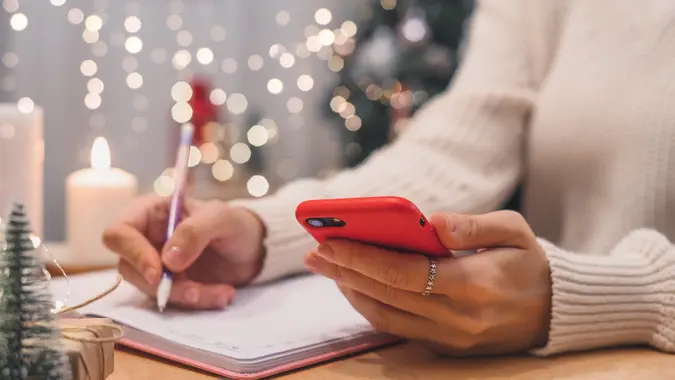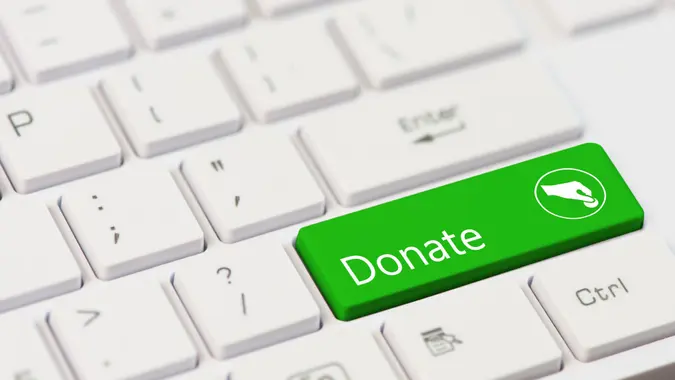5 Buying Habits That Experts Believe Are Key Signs of a Looming Recession

Commitment to Our Readers
GOBankingRates' editorial team is committed to bringing you unbiased reviews and information. We use data-driven methodologies to evaluate financial products and services - our reviews and ratings are not influenced by advertisers. You can read more about our editorial guidelines and our products and services review methodology.

20 Years
Helping You Live Richer

Reviewed
by Experts

Trusted by
Millions of Readers
Is a recession coming? While no one can know for sure — there are some tell-tale signs to watch out for. And one of those signs is consumer money-spending habits.
We chatted with two financial experts about what spending habit changes might indicate that a recession is looming.
What is a Recession?
A recession is defined as a slowdown in economic productivity, increased unemployment and lessened consumer spending. An economic recession is, as defined by a country’s Gross Domestic Product (GDP), at least two consecutive quarters of negative economic growth.
In the U.S., this means that the economy isn’t growing year-over-year, underperforming the previous year’s output.
As part of a recession, there are also usually large layoffs that end up making the news, as well as declining business revenues — as consumers are simply trying to save money, or don’t have extra money to spend.
What Are Recession Indicators?
Recessions often come with tell-tale signs that the economy is stressed. Here are a few recession indicators to watch out for:
Lower Gross Domestic Product (GDP)
The Gross Domestic Product measures the output of an entire economy. When the GDP slows down or is negative year-over-year — this could indicate a recession is near. And the definition of an economic recession is two quarters of reported negative GDP — so keeping an eye on this number can help.
Higher Unemployment
When unemployment rises — this can mean that businesses are stressed financially. An uptick in unemployment several months in a row can indicate that a recession is coming.
Inverted Yield Curve
This stat is a little more complicated — but essentially when short-term interest rates on bonds are higher than long-term rates — this has indicated a recession is almost inevitable.
Inverted yield curves typically happen when interest rates are hiked quickly (as happened in 2022 and 2023) to combat rising inflation.
Higher rates put stress on the economy and can lead to a recession.
Lower Consumer Expenditures
When average household consumer expenditures decrease–this means the economy suffers. Many businesses rely on increased consumer spending to grow — and when the slows down, the entire economy might be heading for a recession.
Buying Habits That Could Indicate a Recession Is Coming – According to Experts
While layoffs and a decrease in economic output are lagging indicators of a recession (you don’t see them until it’s too late)–what people are spending money on is a leading indicator of a recession. This means that an analysis of consumer spending can help reveal whether a recession is looming or not.
Here are a few buying habits that could indicate a recession is coming (according to experts):
Buying Generic Instead of Name Brand Goods
“Households start buying more private label or lower-cost goods, especially for staples,” said Dieter Hsiao, an ECommerce growth expert and CEO of DIVISA. “My clients in grocery and basic apparel see consumers trading down, indicating they have less discretionary income.”
Generic brands are a lower-cost option for a similar product — whether it be food, clothing, or other products. And when things are financially good–many consumers opt for the more expensive name brand product.
But as layoffs start ramping up and discretionary income dries up — consumers will switch to more generic brands to save a few dollars on each purchase. So if you see a rise in the purchase of generic products through your own business or other local businesses — it could be an indication that a recession is around the corner.
Less Eating Out
It’s no secret that restaurants have become very expensive — with consumer inflation data showing a significant increase in prices of dining out over the last few years. But eating out is a luxury that might get cut from the budget when consumers don’t have access to the same income or excess cash flow they are used to.
“Restaurants and entertainment see declines in higher-margin purchases,” Hsiao said. “People cut back on non-essential items and experiences first. My clients in these sectors are often the first to feel the pinch.”
A leading indicator of a looming recession is consumers choosing to eat out less — and make food at home more. And while this can be a wise choice even when the economy is doing great — when a large percentage of the population stops dining out all at once — it can be a sign of an upcoming recession.
Less New Businesses Being Launched
One spending habit you might not consider being tied to a recession is the formation of new businesses. Whether you’re launching an online business or opening a storefront — when a recession is looming and cash is tight — you might be less likely to take the risk of starting a new venture.
“New businesses form at a slower rate while more established businesses close down,” Hsiao said. “When entrepreneurs and companies foresee leaner times ahead, they are less likely to start new ventures or keep struggling ones afloat.”
Less Luxury Purchases
Luxury purchases are one of the first spending categories to get hit when a recession is coming. Luxury items are beyond something you want — they are the high-end version of a product or service that usually costs far more than competitors.
But when the jobs market starts getting stressed and cash is less plentiful — luxury purchases start to die off.
“Retailers [may] see drops in sales of big-ticket, discretionary goods,” Hsiao said. “People postpone expensive, non-urgent purchases, especially for luxury products. My clients selling fashion, beauty and jewelry are often impacted here.”
Rising Consumer Debt
In addition to spending less on luxury items and other “want” items in your budget — another indicator of a recession could be rising consumer debt. Spending habits can be hard to break — and when the budget shrinks — some consumers may turn to debt to continue spending.
An increase in overall credit card debt, auto loans and other types of consumer debt can indicate that the economy is in poor shape and consumers can’t afford daily purchases.
“Consumers take on more debt relative to income,” Hsiao said. “As available cash tightens, people turn to credit cards and loans to maintain their lifestyle. This debt overhang suggests lower future spending.”
Increased Savings Rate
While not a buying habit — tracking consumer savings rates can help indicate how people are feeling about the economy in general. An uptick in consumer savings rates could mean that people are feeling uncertain and feel the need to stack cash.
“At the onset of a recession, people become worried about their job security and future financial stability,” said Danny Colacicco, founder and CEO of Panda Pro Home Buyers. “As a result, they tend to increase their savings rate and cut back on unnecessary expenses such as dining out, travel, and luxury items.”
You can track personal savings rates through the Federal Reserve website here. As you can see, personal savings rates soared during the pandemic — which happens to be the last recorded recession as well.
If savings rates start to spike, it could mean consumers are worried about what’s to come.
More From GOBankingRates
- Nearly 1 in 3 Americans Hit by a Costly Holiday Scam, Norton Survey Shows -- How To Avoid This
- Here's What Retirees Wasted the Most Money On in 2025 -- and How To Avoid It in 2026
- How Middle-Class Earners Are Quietly Becoming Millionaires -- and How You Can, Too
- 6 Safe Accounts Proven to Grow Your Money Up to 13x Faster
Our in-house research team and on-site financial experts work together to create content that’s accurate, impartial, and up to date. We fact-check every single statistic, quote and fact using trusted primary resources to make sure the information we provide is correct. You can learn more about GOBankingRates’ processes and standards in our editorial policy.
 Written by
Written by  Edited by
Edited by 

























